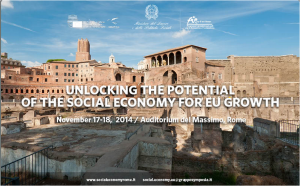
Social impact: what should be measured and reported, and how?
Τhe following lines are part of my contribution on the Work Group 9 of the Conference on Social Impact.
- Following Europe 2020 strategy and the monitoring of its overall progress on economy through indicators we propose a new framework combining micro- and macro indicators.
- Various social impact metrics exist within social economy on a micro level
- A voluntary common European social impact model -derived from extended EU consultation, among academics, experts and practitioners- would act as the basis for common grounds of the social economy ecosystems in EU member states.
- This EU Social Impact model would involve the unity in diversity of the various social economy ecosystems.
- GDP doesn’t include social metrics. “Beyond GDP” EU Commision’s initiative could be linked with social impact metrics.
On 3 March 2010 the European Commission adopted its Europe 2020 strategy, saying: The European Commission will monitor annually the situation on the basis of a set of indicators showing overall progress towards the objective of smart, green and inclusive economy delivering high levels of employment, productivity and social cohesion. Starting with this we would like to claim also that Reporting and/or impact metrics system on a voluntary basis as self assessment tools and as tools for disseminating social, environmental and economic contribution are vital for social enterprises. A link of the micro- metrics and reporting like IRIS metrics or Social Reporting Standard to macro- indicators such as OECD’s Better Life Index, or Social Progress Imperative for a more thorough picture of the social economy organisations and their societal environmental and economic impact could meaningfully interconnect social economy organisations to society and track their contribution to a viable society.
A voluntary common European social impact model -derived from extended EU consultation, among academics, experts and practitioners- like the equivalent of Common Assessment Framework (CAF) for the EU public organisations could assist the cause and provide a common language and metrics within the social economy sector along with the public sector. Social Impact is not measured officially, in the national accounts. Hence, it will be presented a search for new combined sets of wealth and societal progress apart from the GDP could be developed.
We advocate on the development of a voluntary combined social impact model that will offer the vocabulary, the understanding and will assist on a sustainable mode the ecosystem of public organisations and social enterprises. Social Economy as Economy is a subsystem of the Society. It has to serve it on a meaningful, just and effective way. A voluntary model is preferred than a compulsory model which will regulate from a top down approach the impact measurement. We have set up this combined model merging Social Reporting Standard with Common Assessment Framework. CAF has been proved to work in all these years in various European countries and within a vast range of public organisations and agencies. Keeping the general outline of the model and its metrics through self assessment will offer a meaning on a simple and understandable way. Through the preconditions and results groups of metrics and through Social Innovation and Learning the key performance results (criterion 9) are transformed into social impact results. We are proposing a grading system as CAF applied to the proposed combined model.
Furthermore, metrics of social impact on a social enterprise level could add to calculate social metrics of initiatives like EU’s “Beyond GDP”. The Beyond GDP initiative is about developing indicators that are as clear and appealing as GDP, but more inclusive of environmental and social aspects of progress. Economic indicators such as GDP were never designed to be comprehensive measures of prosperity and well-being. There is a need for adequate indicators to address global challenges of the 21st century such as climate change, poverty, resource depletion, health and quality of life. Without wanting to hold the floor further I would conclude and suggest that given the profound effectiveness of systemic self assessment organizational models and social impact models as well as the need to develop a link between micro and macro environments in the field of Social Economy and Social Entrepreneurship with public organisations affecting the way we measure GDP as well as a common language of communication among public authorities, social business and social finance actors.